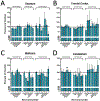The contributions of neonatal inhalation of copper to air pollution-induced neurodevelopmental outcomes in mice
- PMID: 38081392
- PMCID: PMC10842733
- DOI: 10.1016/j.neuro.2023.12.007
The contributions of neonatal inhalation of copper to air pollution-induced neurodevelopmental outcomes in mice
Abstract
Exposures to ambient ultrafine particle (UFP) air pollution (AP) during the early postnatal period in mice (equivalent to human third trimester brain development) produce male-biased changes in brain structure, including ventriculomegaly, reduced brain myelination, alterations in neurotransmitters and glial activation, as well as impulsive-like behavioral characteristics, all of which are also features characteristic of male-biased neurodevelopmental disorders (NDDs). The purpose of this study was to ascertain the extent to which inhaled Cu, a common contaminant of AP that is also dysregulated across multiple NDDs, might contribute to these phenotypes. For this purpose, C57BL/6J mice were exposed from postnatal days 4-7 and 10-13 for 4 hr/day to inhaled copper oxide (CuxOy) nanoparticles at an environmentally relevant concentration averaging 171.9 ng/m3. Changes in brain metal homeostasis and neurotransmitter levels were determined following termination of exposure (postnatal day 14), while behavioral changes were assessed in adulthood. CuxOy inhalation modified cortical metal homeostasis and produced male-biased disruption of striatal neurotransmitters, with marked increases in dopaminergic function, as well as excitatory/inhibitory imbalance and reductions in serotonergic function. Impulsive-like behaviors in a fixed ratio (FR) waiting-for-reward schedule and a fixed interval (FI) schedule of food reward occurred in both sexes, but more prominently in males, effects which could not be attributed to altered locomotor activity or short-term memory. Inhaled Cu as from AP exposures, at environmentally relevant levels experienced during development, may contribute to impaired brain function, as shown by its ability to disrupt brain metal homeostasis and striatal neurotransmission. In addition, its ability to evoke impulsive-like behavior, particularly in male offspring, may be related to striatal dopaminergic dysfunction that is known to mediate such behaviors. As such, regulation of air Cu levels may be protective of public health.
Keywords: Air pollution; Copper; Dopamine; Metal dyshomeostasis; Neurodevelopmental disorders; Ultrafine particulate matter.
Copyright © 2023 The Authors. Published by Elsevier B.V. All rights reserved.
Conflict of interest statement
Declaration of Competing Interest The authors declare that they have no known competing financial interests or personal relationships that could have appeared to influence the work reported in this paper.
Figures










References
-
- Abi-Dargham A, Gil R, Krystal J, Baldwin RM, Seibyl JP, Bowers M, van Dyck CH, Charney DS, Innis RB, Laruelle M, 1998. Increased striatal dopamine transmission in schizophrenia: confirmation in a second cohort. Am J Psychiatry 155(6), 761–767. - PubMed
-
- Al-Hasani R, Gowrishankar R, Schmitz GP, Pedersen CE, Marcus DJ, Shirley SE, Hobbs TE, Elerding AJ, Renaud SJ, Jing M, Li Y, Alvarez VA, Lemos JC, Bruchas MR, 2021. Ventral tegmental area GABAergic inhibition of cholinergic interneurons in the ventral nucleus accumbens shell promotes reward reinforcement. Nat Neurosci 24(10), 1414–1428. - PMC - PubMed
-
- Allen JL, Liu X, Pelkowski S, Palmer B, Conrad K, Oberdorster G, Weston D, Mayer-Proschel M, Cory-Slechta DA, 2014a. Early postnatal exposure to ultrafine particulate matter air pollution: persistent ventriculomegaly, neurochemical disruption, and glial activation preferentially in male mice. Environ Health Perspect 122(9), 939–945. - PMC - PubMed
-
- Allen JL, Liu X, Pelkowski S, Palmer B, Conrad K, Oberdorster G, Weston D, Mayer-Proschel M, Cory-Slechta DA, 2014b. Early postnatal exposure to ultrafine particulate matter air pollution: persistent ventriculomegaly, neurochemical disruption, and glial activation preferentially in male mice. Environmental health perspectives 122(9), 939–945. - PMC - PubMed
MeSH terms
Substances
Grants and funding
LinkOut - more resources
Full Text Sources
Medical
Research Materials

